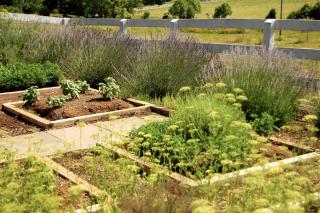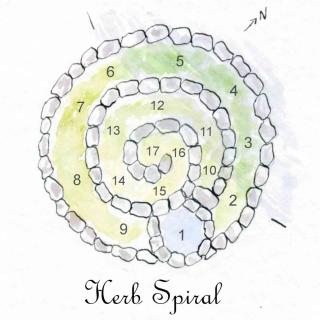

Herbs, today, are definitely among favored options when planting an ornamental garden. Purple basil, the many varieties of oregano and thyme, graphic-leaved fennel… All these fragrant wonders turn flower beds into olfactory landscapes, too! Most even have no fear of drought or excess sun: they’ll just keep growing even in rocky soil, flower beds, sneak along between tiles on a terrace or plump out a windowsill garden box!

Generally, it’s recommended never to over-use an herb. Even if the plant itself isn’t toxic, if eaten in large amounts and high doses it might still lead to trouble.
Shrubby herbs such as thyme and rosemary are generally considered native to the Mediterranean basin. As a result,they’re ideal to form low edges or to fill in patches of color in a checkered tile garden. Creeping rosemary varieties (Rosmarinus officinalis ‘Pointe du Raz’) will gracefully flow and cover a mound or low wall.
These shrubs need pruning in February, or just after the blooming. Of course, you can always snip a twig off now and then for your cooking. They demand full sun and don’t need any help overcoming drought.
Annual herbs require sowing every year, much of which occurs naturally as they go to seed and die away. Trim them often and water them abundantly after planting. The longer you water, the later they will flower and bear seed. They all love full sun, except for chervil which prefers shade.
There are exceptions, but generally speaking herbs can be classified as follows:
dill (Anethum graveolens)
Here is a landscaping arrangement designed to give each herb exactly the soil and exposure it needs. The trick is to build up a mound with a spiral and a rock wall. Then, settle the plants in the spot that suits them best.
 Stack up soil into a cone about 5 feet tall (160cm) and 3 feet wide (1m). This size is perfect to harvest the herbs without needing to actually climb into the herb spiral. For the base and the center of the spiral, use poor soil, and what’s most important is that it drains very well (mix in gravel, rocks, sticks…).
Stack up soil into a cone about 5 feet tall (160cm) and 3 feet wide (1m). This size is perfect to harvest the herbs without needing to actually climb into the herb spiral. For the base and the center of the spiral, use poor soil, and what’s most important is that it drains very well (mix in gravel, rocks, sticks…).1- watercress 2- parsley 3- mint 4- pennyroyal 5- sorrel 6- celery 7- dill 8- savory 9- chives 10- basil 11- lemon balm 12- tarragon 13- sage 14- hyssop 15- rosemary 16- oregano 17- thyme
The spiral itself provides cooler, shaded spots on one side, and warmer, sunnier spots on the other. Remember to add a mini-pond at the bottom of the spiral to catch runoff: you can plant watercress or water mint.
Go ahead and cut back clumps that grow too large in order to give every plant the same growing space.